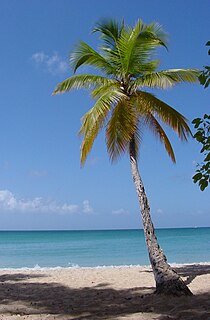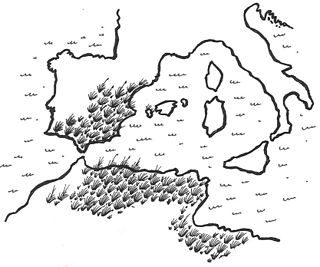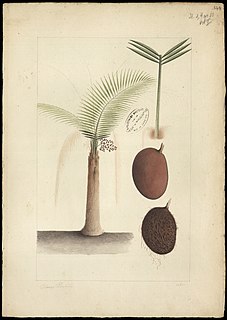
The Arecaceae is a family of perennial flowering plants in the monocot order Arecales. Their growth form can be climbers, shrubs, tree-like and stemless plants, all commonly known as palms. Those having a tree-like form are called palm trees. Currently, 181 genera with around 2,600 species are known, most of which are restricted to tropical and subtropical climates. Most palms are distinguished by their large, compound, evergreen leaves, known as fronds, arranged at the top of an unbranched stem. However, palms exhibit an enormous diversity in physical characteristics and inhabit nearly every type of habitat within their range, from rainforests to deserts.

Thatching is the craft of building a roof with dry vegetation such as straw, water reed, sedge, rushes, heather, or palm branches, layering the vegetation so as to shed water away from the inner roof. Since the bulk of the vegetation stays dry and is densely packed—trapping air—thatching also functions as insulation. It is a very old roofing method and has been used in both tropical and temperate climates. Thatch is still employed by builders in developing countries, usually with low-cost local vegetation. By contrast, in some developed countries it is the choice of some affluent people who desire a rustic look for their home, would like a more ecologically friendly roof, or who have purchased an originally thatched abode.

Esparto, halfah grass, or esparto grass is a fiber produced from two species of perennial grasses of north Africa and southern Europe. It is used for crafts, such as cords, basketry, and espadrilles. Stipa tenacissima and Lygeum spartum are the species used to produce esparto.

Heart of palm is a vegetable harvested from the inner core and growing bud of certain palm trees, most notably the coconut, juçara, açaí palm, palmetto, and peach palm. Harvesting of many uncultivated or wild single-stemmed palms results in palm tree death. However, other palm species are clonal or multi-stemmed plants and moderate harvesting will not kill the entire clonal palm. Heart of palm may be eaten on its own, and often it is eaten in a salad.

Attalea maripa, commonly called maripa palm is a palm native to tropical South America and Trinidad and Tobago. It grows up 35 m (115 ft) tall and can have leaves or fronds 10–12 m (33–39 ft) long. This plant has a yellow edible fruit which is oblong ovoid and cream. An edible oil can be extracted from the pulp of the fruit and from the kernel of the seed.

Leopoldinia piassaba, the Para piassava, piassava fiber palm or piassava palm, is a palm native to black water rivers in Amazonian Brazil and Venezuela, from which is extracted piassava, a high caliber and water resistant fiber. Piassaba fiber is made into brooms, baskets, and other products. This plant is also a natural habitat of the Rhodnius brethesi, which is a potential vector of Chagas disease, and it is cited in Flora Brasiliensis by Carl Friedrich Philipp von Martius.

Piassava, also piaçava, piaçaba, piasaba, pissaba, piassaba, and piaçá, is a fibrous product of Brazilian palm species Attalea funifera and Leopoldinia piassaba. It is often used in making brooms and for other purposes.

Attalea speciosa, the babassu, babassu palm, babaçu, or cusi, is a palm native to the Amazon Rainforest region in South America. The babassu palm is the predominant species in the Maranhão Babaçu forests of Maranhão and Piauí states.

Attalea crassispatha is a palm which is endemic to southwest Haiti. The most geographically isolated member of the genus, it is considered a critically endangered species and has been called one of the rarest palms in the Americas.

Attalea is a large genus of palms native to Mexico, the Caribbean, Central and South America. This pinnately leaved, non-spiny genus includes both small palms lacking an aboveground stem and large trees. The genus has a complicated taxonomic history, and has often been split into four or five genera based on differences in the male flowers. Since the genera can only be distinguished on the basis of their male flowers, the existence of intermediate flower types and the existence of hybrids between different genera has been used as an argument for keeping them all in the same genus. This has been supported by recent molecular phylogenies.
Attalea osmantha is a large pinnately leaved palm found in Trinidad and Tobago and northern Venezuela.

Ampelodesmos is a genus of Mediterranean plants in the grass family, which is known by the common names stramma, Mauritania grass, rope grass, and dis(s) grass. It is classified in its own tribe Ampelodesmeae within the grass subfamily Pooideae.
Aphandra is a monotypic genus of flowering plant in the palm family native to the Amazon rainforest vegetation in South America. Its only species is Aphandra natalia, sometimes called mastodon palm or fiber palm, and is used by indigenous peoples in the construction of brooms and other products. This plant is commercially exploited for its edible fruits, and for its leaf sheath and petiole fibers. This fiber is almost equal to the fiber extracted from Attalea funifera and Leopoldinia piassaba, which is called piassava.

Koeleria macrantha is a species of grass known by the common name prairie Junegrass in North America and crested hair-grass in the UK. It is widespread across much of Eurasia and North America. It occurs in many habitat types, especially prairie.
Neonothopanus gardneri, locally known as flor de coco, is a bioluminescent fungus native to Goiás, Piauí and Tocantins states in Brazil.

Attalea phalerata is a species of palm tree known by the English common name urucuri palm, the Portuguese common name urucurizeiro, and the Spanish common name shapaja. Other common names include motacu and bacuri. It is native to Brazil, Bolivia, Paraguay, and Peru, where it grows along southern and western Amazonia. It is the most common palm tree on the Pantanal.

The Baré, or Hanera, and Werekena are related indigenous people of northwest Brazil and Venezuela. For many years they suffered from violent exploitation by Portuguese and Spanish merchants, forced to work as debt slaves. They moved often to try to avoid the merchants. Today most live by agriculture, hunting, fishing and gathering, and extract piassava fiber for income to buy goods from traders.

The Orinoco wetlands (NT0906) is an ecoregion of northeast Venezuela within the northern Orinoco Delta. It holds areas of tall grasses in flooded land, surrounded by mangroves and swamp forest, giving way to the drier Llanos savanna in the west.















